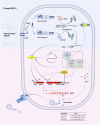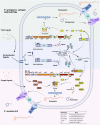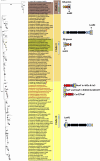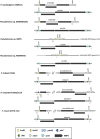Does regulation hold the key to optimizing lipopeptide production in Pseudomonas for biotechnology?
- PMID: 38476965
- PMCID: PMC10928948
- DOI: 10.3389/fbioe.2024.1363183
Does regulation hold the key to optimizing lipopeptide production in Pseudomonas for biotechnology?
Abstract
Lipopeptides (LPs) produced by Pseudomonas spp. are specialized metabolites with diverse structures and functions, including powerful biosurfactant and antimicrobial properties. Despite their enormous potential in environmental and industrial biotechnology, low yield and high production cost limit their practical use. While genome mining and functional genomics have identified a multitude of LP biosynthetic gene clusters, the regulatory mechanisms underlying their biosynthesis remain poorly understood. We propose that regulation holds the key to unlocking LP production in Pseudomonas for biotechnology. In this review, we summarize the structure and function of Pseudomonas-derived LPs and describe the molecular basis for their biosynthesis and regulation. We examine the global and specific regulator-driven mechanisms controlling LP synthesis including the influence of environmental signals. Understanding LP regulation is key to modulating production of these valuable compounds, both quantitatively and qualitatively, for industrial and environmental biotechnology.
Keywords: Pseudomonas; antibiotics; bioengineering; bioprocessing; biosurfactants; lipopeptides; regulation; specialized metabolites.
Copyright © 2024 Zhou, Höfte and Hennessy.
Conflict of interest statement
The authors declare that the research was conducted in the absence of any commercial or financial relationships that could be construed as a potential conflict of interest. The author(s) declared that they were an editorial board member of Frontiers, at the time of submission. This had no impact on the peer review process and the final decision.
Figures










Similar articles
-
Transporter Gene-Mediated Typing for Detection and Genome Mining of Lipopeptide-Producing Pseudomonas.Appl Environ Microbiol. 2022 Jan 25;88(2):e0186921. doi: 10.1128/AEM.01869-21. Epub 2021 Nov 3. Appl Environ Microbiol. 2022. PMID: 34731056 Free PMC article.
-
Genetic regulations of the biosynthesis of microbial surfactants: an overview.Biotechnol Genet Eng Rev. 2008;25:165-85. doi: 10.5661/bger-25-165. Biotechnol Genet Eng Rev. 2008. PMID: 21412355 Review.
-
Charting the Lipopeptidome of Nonpathogenic Pseudomonas.mSystems. 2023 Feb 23;8(1):e0098822. doi: 10.1128/msystems.00988-22. Epub 2023 Jan 31. mSystems. 2023. PMID: 36719227 Free PMC article.
-
Lipopeptide families at the interface between pathogenic and beneficial Pseudomonas-plant interactions.Crit Rev Microbiol. 2020 Aug;46(4):397-419. doi: 10.1080/1040841X.2020.1794790. Epub 2020 Sep 4. Crit Rev Microbiol. 2020. PMID: 32885723 Review.
-
Interdisciplinary Overview of Lipopeptide and Protein-Containing Biosurfactants.Genes (Basel). 2022 Dec 26;14(1):76. doi: 10.3390/genes14010076. Genes (Basel). 2022. PMID: 36672817 Free PMC article. Review.
Cited by
-
Drosophila attraction, colonization, contagion, and mortality by Pseudomonas spp. and toxicity of their biosurfactants.Appl Microbiol Biotechnol. 2025 Jun 4;109(1):135. doi: 10.1007/s00253-025-13518-x. Appl Microbiol Biotechnol. 2025. PMID: 40464961 Free PMC article.
References
Publication types
LinkOut - more resources
Full Text Sources
Miscellaneous

